.
|
San Onofre Edison... West Coast Radiation Crisis - Part 1
By Yoichi Shimatsu Exclusive to Rense.com 4-23-13 |
|
|
Beached in front of the San Onofre nuclear power plant,
the carcass of a California sea lion was remarkable, for being an adult
specimen. So far, throughout the six-week crisis for marine mammals along
the Southern California coastline, all of the 2,000-plus sea lions, elephant
seals and harbor seals suffering severe malnutrition have been pups deprived
of breast milk from their emaciated or missing mothers.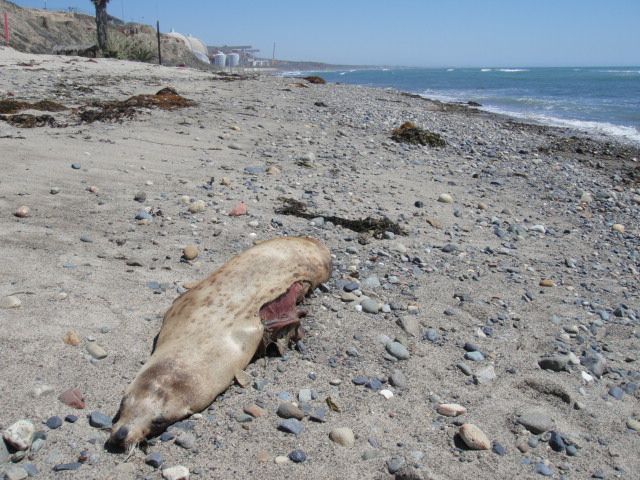
Dead sea lion on San Onofre beach,
150 meters north of the Edison nuclear power plant, seen behind.
Veterinarians and volunteers at marine mammal rescue centers from San Pedro to Laguna Beach (roughly between Los Angeles and San Diego) have been puzzled by this inexplicable pup crisis. The assumption is that of mass starvation being caused by a shortage of near-shore fish, which forced the mothers to venture far out to sea. While there has been a long-term trend of population decline among smaller piscine species and mollusks, a sudden drastic drop in sardine numbers this spring is unlikely, considering the large numbers of dolphins seen offshore in pursuit of schools of fish. 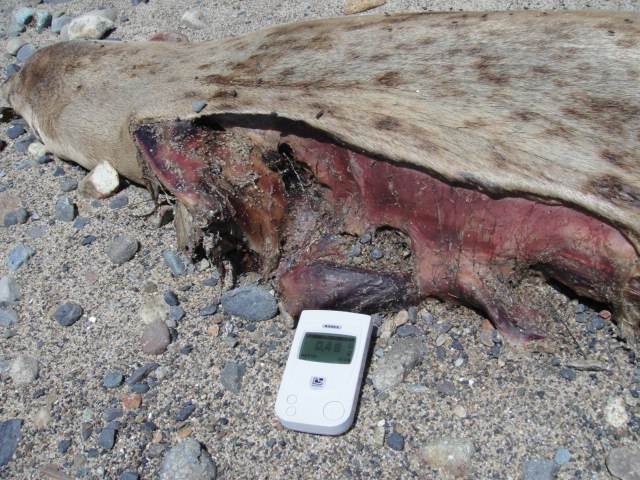
Very high radiation readings near
its heart and liver.
The feed scarcity theory is also inconsistent with the daily tally posted by fishermen at docks along the Southern California coast. Game fish that predate on mollusks and smaller fishes are still being caught in large numbers with rod and reel. Therefore the crisis faced by shore-based marine mammals must have a different cause. 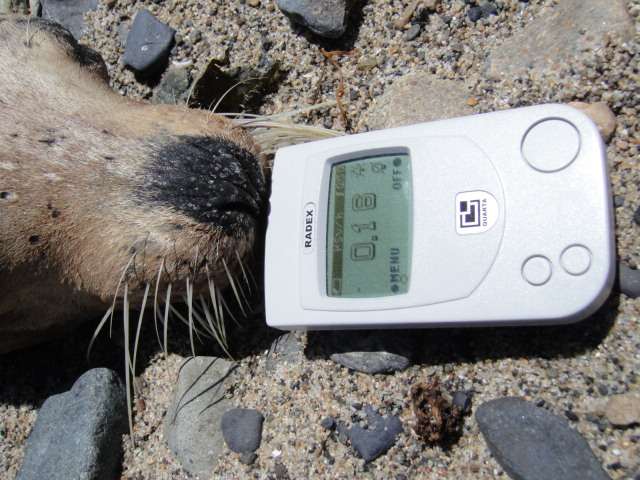
Exposure levels around its nose
and mouth.
A Field Autopsy Now here, lying on the sand, was a dead sea lion whose internal organs lay exposed by a long rip down its left side. The jaws of a thrashing shark were not what finished her off since no teeth marks were visible on the pale brown hide. The strip of skin had been pulled off in a single motion. 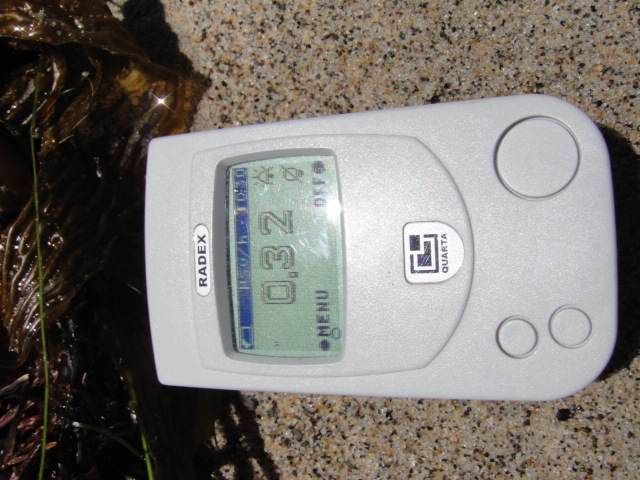
A seaweed clump lying directly
in front of Southern
California Edison reactor has a high reading. The front flipper on its left side was snapped off in a clean break along the knuckles, indicating the sea lion had been snagged possibly by a towing cable for a barge or a rope to a net dragged by a squid boat. The animal was slightly over 2 meters from nose to rear flippers. Its midriff was absent of bulging body fat, a sign of malnutrition as in the underweight pups treated at a local marine mammal rescue center. A quick scan with a dosimeter revealed that the sea lion was radioactive. More careful measurements disclosed a shocking 0.48 microsieverts in the heart and liver region. The second most affected area was its rear flippers, probably due to repeated contact with fecal excretions. The nose and mouth were a bit less contaminated. Surprisingly, the intestines showed hardly any sign of radioactive residues. The lack of any fishy odor in the water oozing out of the gut indicated the sea lion had not eaten for a long while before dying. 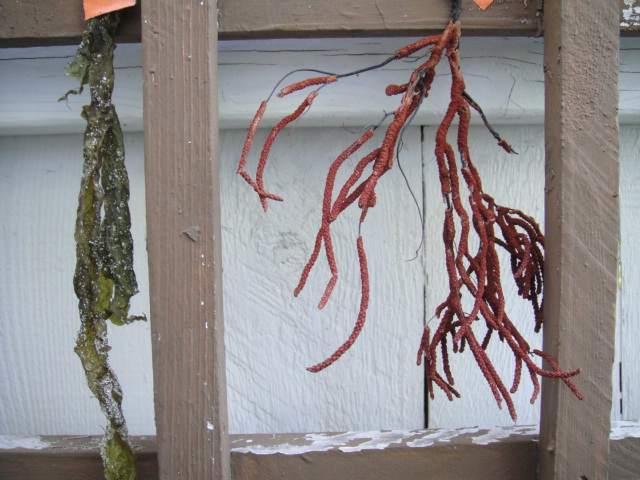
Kelp and gorgonian samples hung
out to dry.
The internal readings suggest the probable cause of death
as ingestion of radioactive feed, mainly through fish in its diet (and
algae inside the fishes’ bellies) and secondarily immersion in seawater.
Moving from the digestive tract into the bloodstream, nuclear isotopes
were bio-accumulated in the internal organs, especially cesium concentrating
in the heart muscle. Cesium is known to cause irregular beat, cell abnormalities,
muscle atrophy and spasms leading to a seizure and cardiac arrest.With its body weakening and coordination becoming spastic, the sea lion could not maintain the speed and maneuverability required to pursue and catch free-swimming fish. It thus became too exhausted to avert an entanglement with a passing cable, which pulled off its left flipper. This is terrible way for a mermaid to die and drift ashore where hordes of flies were now crawling over its open wound and beige fur. 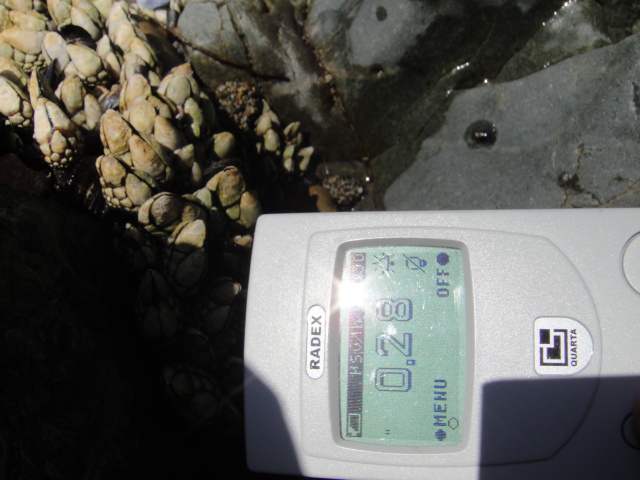
Barnacles on Catalina rocks are
heavily irradiated.
There are two known sources of radioactive contamination along the West Coast: the North Pacific Current conveying coolant dumped from the melted-down Fukushima TEPCO facility; and the Columbia River containing wastewater from the Hanford nuclear weapons plant in Washington State. Yet, here, the high radioactive levels found in a sea lion point to a third nuclear culprit, the Southern California Edison at San Onofre. Surfin’ USA The long stretch of San Onofre beach is famous for pipeline surfing, as immortalized by one of the Beach Boys’ odes to endless summer. The curving sandy track, which was once plied by classic woodies, still runs past sun-tanned youths paddling their boards into the breakers. The car track shrinks into a footpath that ends at a pile of gray rocks and tall signboards warning: “No Entry Past the Beach.” A dune buggy carrying a couple of black-shirted security guards passes me and rolls onto a concrete ramp, which rises under a watch tower where they don hardhats and walk up toward the two white domes of the SCE nuclear station. 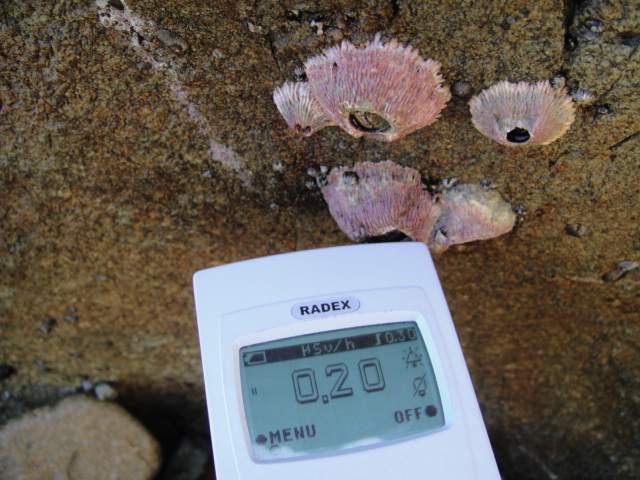
Limpet shellfish are also toxic.
Electricity generation at SCE San Onofre ceased in January 2012 due to leaks in its steam generator, reportedly without any release of radioactive isotopes. More than a year later, Edison officials announced a plan to seek regulatory approval for a restart of Reactor 2. At the very same moment in early March, rescue centers from San Pedro to Laguna Beach were overwhelmed with starving sea lion pups, which soon totaled more than 2,000 cases. 
A sea kayak can float but is unsafe
from radioactive contamination.
The question thus arises: Did Edison officials secretly approve the hosing down of the San Onofre plant in preparation for inspection by the Nuclear Regulatory Commission? Answers in Seaweed Since there has been no radiation monitoring along the West Coast after the Obama administration’s order to cease data-collecting on fallout from Fukushima in mid-2011, there is only one readily available method for detecting recent radioactive releases: Comparison of contamination levels in wet and dry samples of local seaweed. 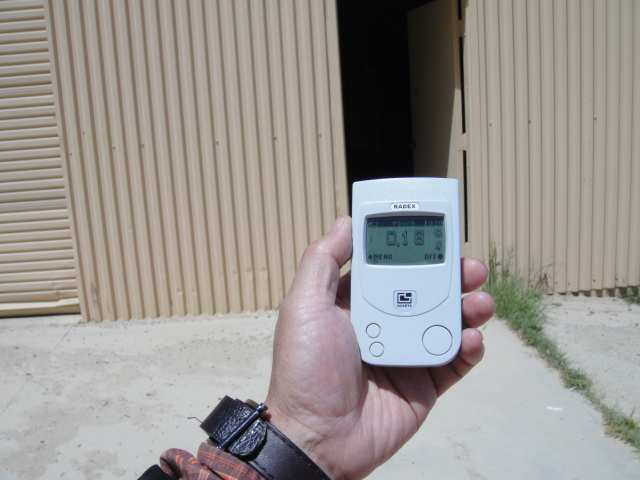
Doorway of unmarked building at
SCE Catalina Island, while the
garage roll-up entrance had a reading of 0.24 microsieverts. Using both a dosimeter and Geiger counter, I measured samples of wet seaweeds and then dried these for a second reading of the plant material minus its water content. While many seaweed types can be found in the clumps dotting the shore, the focus was on two species with different physical characteristics: kelps and red gorgonian. Kelp grows rapidly in the late winter-early spring with a high rate of cell division. Fast growth promotes the intake of nutrients and bio-accumulation of radioactive isotopes. In contrast, red gorgonian is a slow grower with hard coral-like “fingers” that requires a much longer period for absorption of dissolved minerals. Wet samples registered fairly high readings. After drying, the levels in the kelp dropped by about 25 percent. Dried gorgonian, in contrast, showed much lower readings and barely any residual radiation, meaning that the radioactive content was present mainly in the aqueous slime on the outside of the plant rather than inside its cells. A comparison of older kelp versus this season’s growth, done later on Catalina Island, showed similar results. The radioactivity count in a single growing season (March-April 2013) was double the total contamination accumulated over several past years in an older sample. Therefore, there must have been a massive unreported and illegal release from SCE San Onofre at some point between February and early March. Fukushima ‘Hot’ Levels in California The clumps of seaweeds in front of SCE Onofre registered between 0.18 and 0.38 microsieverts, in the same range as those I measured on the shore of south Fukushima prefecture. The Catalina readngs of 0.12 to 0.18 microsieverts in seaweed and 0.28 in barnacles and 0.20 limpets is higher than my findings at the Abukuma River basin near the border of Fukushima and Miyagi prefectures. (Note: By comparison, readings taken on the Japanese coast just south of the Fukushima No.2 plant were extremely high, often more than 1.2 microsieverts per hour.) 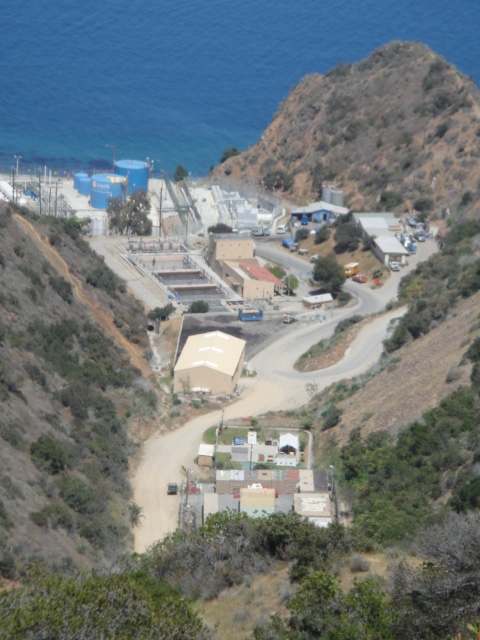
Aerial view of the unmarked warehouse
(left side of road) below the
water treatment pools, hazardous waste site (bottom right), and the oil tanks of the SCE Catalina gas-and-oil thermal power facility (top). These preliminary field studies at San Onofre and Catalina indicate that Edison power is primarily responsible for the kill-off and injuries to marine mammals along with possible illnesses among the human population of Southern California. This conclusion does not exonerate the nuclear operators at Hanford or Fukushima for their roles in the larger West Coast radiation crisis. The Curious Case of Catalina Another question that comes up is: If the powerful California Current flows southward, how can radioactive wastewater flow in the opposite direction from San Onofre past Laguna Beach all the way to San Pedro, a distance of 100 kilometers north? Along the Golden State’s irregular coastline, the passing current and waves strike outcrops and submerged rock formations, generating reflected waves and swirling eddies that move back toward the sea, sometimes for long distances. These counter-movements are amplified by the ebb tide. 
Crow feather reveals exposure to
irradiated garbage
at Catalina landfill on SCE property. The sea lion incidents are occurring under even more complex conditions. The waters between San Pedro and San Onofre are complicated by the relatively shallow undersea shelf which extends to and resurfaces as the rugged terrain of Catalina Island. Since scant research has been published on the currents in this marine micro- environment, I took a ferry to Catalina to measure radiation in seaweeds there. The kelp along Catalina’s eastern shore had about a third lower radiation level than those in San Onofre, which is still considerably high since the island is 26 nautical miles or about 41 kilometers away. This level of contamination is possible only if a clockwise current flows from the southeast, that is, from “SanO” to Avalon. This cyclical movement is possibly generated by the southeasterly thrust of the California Current across the gap between northern Catalina and Los Angeles. This powerful stream could well be tugging at the mouth of the Catalina channel, its pull creating a steady flow from San Onofre to Catalina. If the Catalina channel turns out to act as a slow whirlpool, repeatedly circulating radioactive wastewater, this cycle could set up a major kill-off in the months and years ahead. Residents along the coastal bluffs have recently spotted abnormal migrations of orca whales, apparently fleeing the Arctic region, where Fukushima radiation and chemical pollutants are fouling the northern waters. Humpback whales have also been spotted moving south instead of northward. After escaping the contaminated northern feeding grounds, these large mammals are entering the “killing fields” of the Southern California coastal region. Fukushima, Hanford and San Onofre are the “Bermuda Triangle” for marine life. Hidden Dump Site After tentatively solving the sea lion mystery, I decided to hike onward to the Pacific side of Catalina island and made a disturbing discovery along the way. A confusing road map put me past Pebbly Beach, where SCE operates a gas-and-oil electricity plant. After losing my direction, I stumbled upon a hazardous waste site and an unmarked sheet-metal warehouse. Taking out my dosimeter by instinct, I was surprised to find a high radiation reading since the only potential radioactive sources on the list of “acceptable” garbage consists of electronics equipment and monitors. Across the road, the open door of an unmarked building registered a 0.16 microsievert, while the roll-up garage door hit a whopping 0.24. At that exact moment, a SCE service truck came out of nowhere, sped up the road, and screeched to a halt. Two maintenance workers jumped out of the cab, strode right in front of me and locked the door. Responding to their query, I stated that the island map put me in the wrong place. Trudging back toward the junction, I switched on the dosimeter in front of the SCE generation furnaces, where chimneys were belching metallic-tasting fumes, and the numbers again skyrocketed back to 0.28. Higher up the mountain under the power lines from the plant, a crow’s feather lay on the ground. The black plume registered 0.19, and a nearby lump of crow scat was equally contaminated. There is only one possible explanation: The crows feed at the nearby garbage dump where radioactive waste is also being secretly buried. Gazing from the heights, I could see concrete mixers and earthmovers working on a huge new building, which goes unmentioned in SCE press releases. Is Edison quietly dumping low-level nuclear waste from its San Onofre nuclear facility in this hidden corner of Catalina, one of California’s top destinations world-famous for ecological conservation? If so, Edison is being run more like the mafia than a public utilities corporation. The board of SCE is just begging to be busted. Final questions: Where is the state and federal Environmental Protection Agency in this regional radiation crisis? Is any government entity monitoring the radioactivity in Southern California? Why is Jerry Brown, a self-proclaimed environmentalist, asleep at the wheel? Wake up, Governor, these are not moonbeams. SCE San Onofre is emitting death rays. 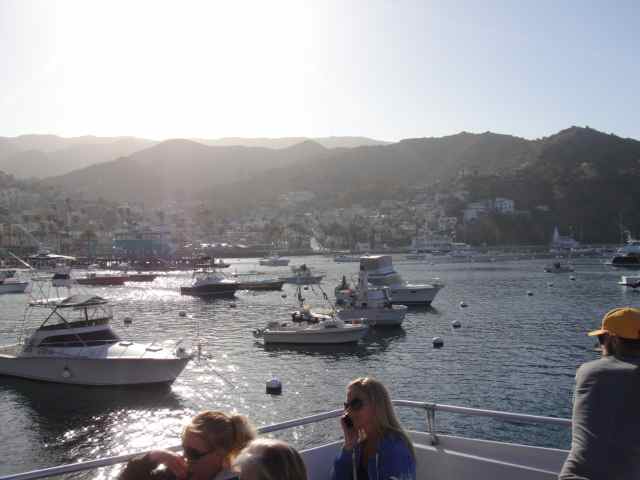
Port of Avalon, Catalina, has a
0.12 microsieverts radiation level.
Additional Notes: Trend Monitoring Needed The readings conducted in the period March 18-22 were, of course, limited by volunteer time and personal expense. While much information can be gleaned from a quick field study, readings taken on a short visit cannot substitute for a trend analysis based on decades of monitoring. One notable and fortunate difference from Fukushima is the low level of radiation on land just outside SCE San Onofre (0.08 to 0.10 microsieverts). This is probably due to the drier climate. Catalina had background radiation on land ranging from 0.04 in shoreline rocks, 0.12 in the serpentine gravel used on dirt tracks, and 0.12 at the ferry terminus, which is probably due to radiation picked up by these ships while crossing the channel. The threat is sufficient to warrant prompt action and more extensive research. Advice to Surfers and Snorkelers A surfer named Jason, who watched while I ran measurements on the deceased sea lion at SanO, asked me: “Is it safe to enter the water at San Onofre?” The summary of my advice to him... The difference between the sea lion and beachgoers is the ingestion of radioactive food. Radioactive isotopes are diluted in the seawater, and it takes many steps up the food chain, from algae to fish, to bio-accumulate (concentrate) radiation. So avoid eating fish species in affected waters, especially rockfish, ling, sand dabs that feed on kelp. A dip in the water is far less dangerous than eating contaminated food. Radioactive salts on the skin are alkali, and therefore acidic soaps and shampoos containing citric acid are advisable. A drink of citrus juice in the late afternoon is also a good choice, since the acidity can help remove isotopes via urine. Sweating is beneficial because it transports isotopes out of the bloodstream. Citrus-laced laundry powder likewise decontaminates clothing, and a second wash in a borax-based detergent can provide a small degree of protection from neutrons. As a Mexican boxer once advised: Don’t drink the water, stick with the beer. In this instance, it’s seawater. Never gulp when swimming. Replace the beer with red wine, which contains radiation-resisting resveratrol. As long as radiation levels do not rise dramatically, staying cooped up in bad indoors air is less safe than being outdoors. Until a meltdown ends California dreaming, youth is still about having fun in the surf and the sun. Yoichi Shimatsu, a science writer based in Hong Kong, conducts radiation-effects research and provides herbal therapy in Fukushima prefecture. |
No comments:
Post a Comment